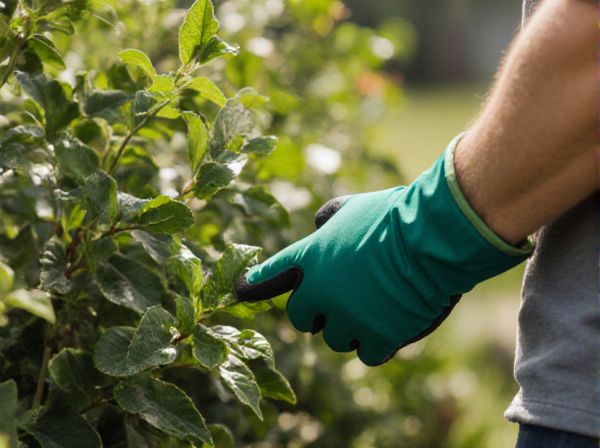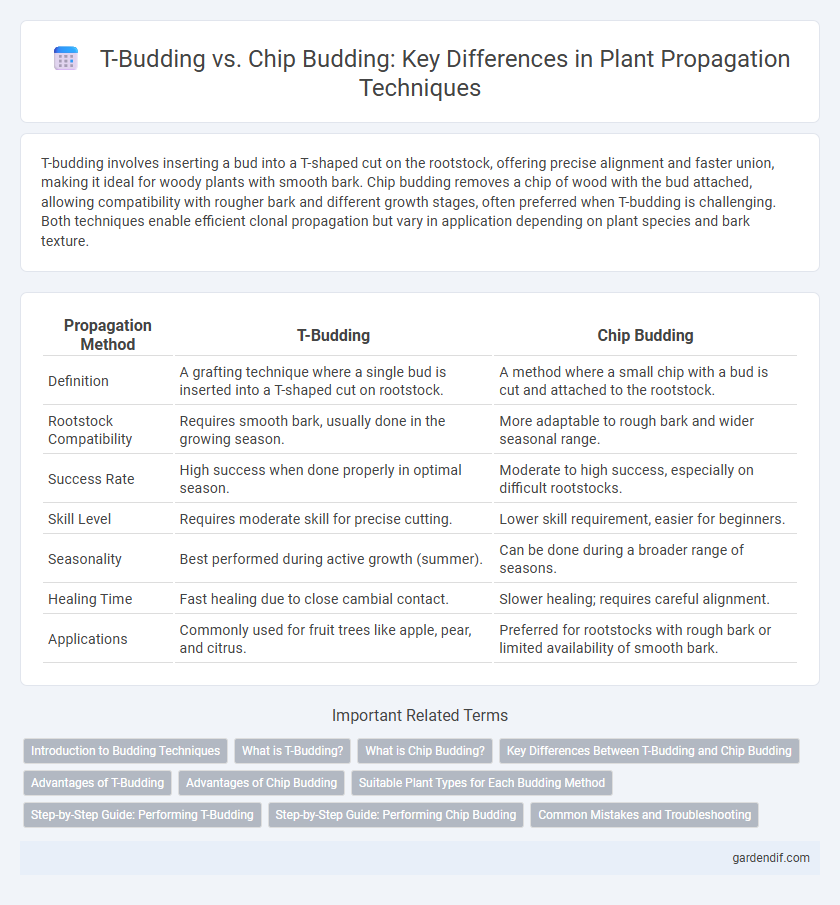
T-budding vs chip budding Illustration
T-budding involves inserting a bud into a T-shaped cut on the rootstock, offering precise alignment and faster union, making it ideal for woody plants with smooth bark. Chip budding removes a chip of wood with the bud attached, allowing compatibility with rougher bark and different growth stages, often preferred when T-budding is challenging. Both techniques enable efficient clonal propagation but vary in application depending on plant species and bark texture.
Table of Comparison
| Propagation Method | T-Budding | Chip Budding |
|---|---|---|
| Definition | A grafting technique where a single bud is inserted into a T-shaped cut on rootstock. | A method where a small chip with a bud is cut and attached to the rootstock. |
| Rootstock Compatibility | Requires smooth bark, usually done in the growing season. | More adaptable to rough bark and wider seasonal range. |
| Success Rate | High success when done properly in optimal season. | Moderate to high success, especially on difficult rootstocks. |
| Skill Level | Requires moderate skill for precise cutting. | Lower skill requirement, easier for beginners. |
| Seasonality | Best performed during active growth (summer). | Can be done during a broader range of seasons. |
| Healing Time | Fast healing due to close cambial contact. | Slower healing; requires careful alignment. |
| Applications | Commonly used for fruit trees like apple, pear, and citrus. | Preferred for rootstocks with rough bark or limited availability of smooth bark. |
Introduction to Budding Techniques
T-budding and chip budding are essential propagation techniques used to clone desirable plants with precision. T-budding involves inserting a bud from the desired plant into a T-shaped cut on the rootstock, promoting rapid union and growth, while chip budding cuts a chip of wood and bark containing the bud to fit onto a similar sized cut on the rootstock. Both methods ensure genetic consistency and are widely employed in fruit tree cultivation and ornamental plant propagation.
What is T-Budding?
T-budding is a vegetative propagation technique where a single bud from the desired plant is inserted into a T-shaped incision on the rootstock's bark, promoting efficient graft union and growth. This method is widely used for fruit trees like citrus and stone fruits due to its high success rate and minimal damage to the rootstock. Compared to chip budding, T-budding allows for easier bark separation and quicker establishment of the grafted bud.
What is Chip Budding?
Chip budding is a vegetative propagation technique in horticulture where a small chip of wood containing a bud is inserted into a matched slit on the rootstock. This method allows for precise alignment of cambium layers, promoting successful union and growth. Chip budding is preferred for its higher success rates and suitability for propagating certain fruit trees and ornamental plants compared to T-budding.
Key Differences Between T-Budding and Chip Budding
T-budding involves inserting a T-shaped bud into the rootstock bark, making it ideal for seasonal propagation when the bark is slipping. Chip budding cuts a chip-shaped piece of wood with a bud from the scion and inserts it into a similar cut on the rootstock, allowing propagation even when the bark is not slipping. T-budding generally requires less skill and is faster, while chip budding offers greater flexibility for various plant species and conditions.
Advantages of T-Budding
T-budding offers higher success rates due to its minimal damage to the rootstock and precise cambium contact, enabling faster and more reliable graft union formation. This method is more adaptable to various plant species and conditions, making it ideal for large-scale propagation in commercial orchards. T-budding also requires less specialized skill compared to chip budding, reducing labor costs and increasing overall efficiency.
Advantages of Chip Budding
Chip budding offers higher success rates in woody plant propagation due to improved cambial contact and reduced tissue damage compared to T-budding. This method is versatile, allowing propagation during a wider range of seasons and on various rootstock sizes. Enhanced compatibility with difficult-to-graft species and better scion alignment further contribute to its growing preference among horticulturists.
Suitable Plant Types for Each Budding Method
T-budding is particularly suitable for fruit trees with thick, mature rootstocks like apples, pears, and stone fruits, where the bark easily slips to accommodate the bud. Chip budding works well with harder-to-bud species such as citrus and walnut trees, featuring thinner or tougher bark that does not slip readily. These methods optimize propagation success by matching the technique to the physiological characteristics of the plant species.
Step-by-Step Guide: Performing T-Budding
T-budding involves making a T-shaped cut on the rootstock bark to insert a single bud from the desired plant, allowing rapid and efficient graft union. Begin by selecting a healthy bud and cutting a protective shield around it, then carefully lift the bark flap on the rootstock and slip the bud into the T-cut. Secure the bud with budding tape and monitor for successful union, which typically forms within two to three weeks, ensuring optimal conditions for sap flow and bark separation.
Step-by-Step Guide: Performing Chip Budding
Chip budding involves carefully selecting a healthy rootstock and preparing a precise chip-shaped cut on its stem, followed by matching a similarly shaped bud taken from the desired scion. Ensuring the cambium layers of both rootstock and bud are aligned is critical to successful graft union and nutrient flow. Wrapping the bud union tightly with budding tape protects it from desiccation and disease while promoting optimal healing during the propagation process.
Common Mistakes and Troubleshooting
Common mistakes in T-budding include improper bark slipping, incorrect timing during active sap flow, and inadequate bud shield placement, which can lead to poor union or bud death. In chip budding, errors often arise from mismatched cambium layers, insufficient bark moisture, or neglecting to secure the bud tightly, resulting in failed grafts or slow healing. Troubleshooting involves ensuring precise alignment of cambium layers, maintaining optimal moisture, and selecting the correct seasonal window for each technique to improve success rates.
T-budding vs chip budding Infographic

 gardendif.com
gardendif.com